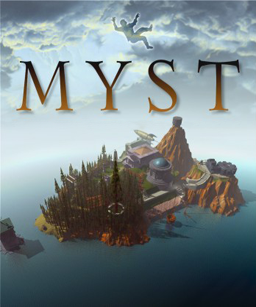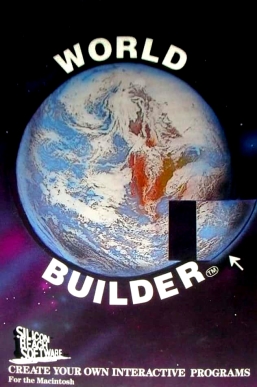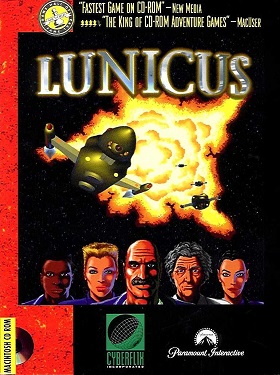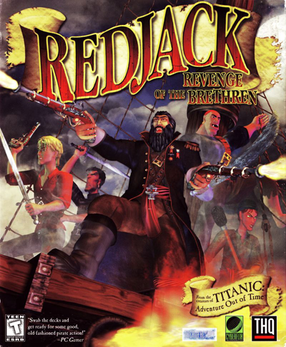
Monkey Island is a series of adventure games. The first four games were produced and published by LucasArts, earlier known as Lucasfilm Games. The fifth was developed by Telltale Games with LucasArts, while the sixth was developed by Terrible Toybox with Lucasfilm Games and Devolver Digital.

Starship Titanic is an adventure game developed by The Digital Village and published by Simon & Schuster Interactive. It was released in April 1998 for Microsoft Windows and in March 1999 for Apple Macintosh. The game takes place on the eponymous starship, which the player is tasked with repairing by locating the missing parts of its control system. The gameplay involves solving puzzles and speaking with the bots inside the ship. The game features a text parser similar to those of text adventure games with which the player can talk with characters.

Myst is an adventure video game designed by Rand and Robyn Miller. It was developed by Cyan, Inc., published by Broderbund, and first released in 1993 for the Macintosh. In the game, the player travels via a special book to a mysterious island called Myst. The player interacts with objects and traverses the environment by clicking on pre-rendered imagery. Solving puzzles allows the player to travel to other worlds ("Ages"), which reveal the backstory of the game's characters and help the player make the choice of whom to aid.

The Fool's Errand is a 1987 computer game by Cliff Johnson. It is a meta-puzzle game with storytelling, visual puzzles, and a cryptic treasure map. It is the tale of a wandering Fool who seeks his fortune in the Land of Tarot and braves the enchantments of the High Priestess. A sequel titled The Fool and His Money was released October 25, 2012.

Star Wars: Dark Forces is a first-person shooter video game developed and published by LucasArts. It was released in 1995 for MS-DOS and Macintosh, and in 1996 for the PlayStation. The story is set in the fictional Star Wars expanded universe and begins shortly before the original Star Wars film, before flashing forward to a year after the film's events. The game's protagonist and playable character is Kyle Katarn, a mercenary working on behalf of the Rebel Alliance who discovers the Galactic Empire's secret Dark Trooper Project, which involves the development of a series of powerful new battle droids and power-armored stormtroopers.

Titanic: Adventure Out of Time is a 1996 point-and-click adventure game developed by CyberFlix and published in the United States and United Kingdom by GTE Entertainment and Europress respectively, for Windows and Macintosh. It takes place in a virtual representation of the RMS Titanic, following a British spy who has been sent back in time to the night Titanic sank and must complete a previously failed mission to prevent World War I, the Russian Revolution, and World War II from occurring. The gameplay involves exploring the ship and solving puzzles. There are multiple outcomes and endings to the game depending on the player's interactions with characters and use of items.

Nocturne is a 1999 action-adventure survival horror video game set in the late 1920s and early 1930s – the Prohibition and Great Depression era. The player takes the part of The Stranger, an operative of a fictional American Government secret organization known as "Spookhouse", which was created by President Theodore Roosevelt to fight monsters. He investigates four strange cases and saves people from classic monsters such as werewolves, zombies, and vampires.

Moonmist is an interactive fiction game written by Stu Galley and Jim Lawrence and published by Infocom in 1986. The game was released simultaneously for the Amiga, Amstrad CPC, Apple II, Atari 8-bit computers, Atari ST, Commodore 64, MS-DOS, TRS-80, TI-99/4A, and Mac. It is Infocom's twenty-second game. Moonmist was re-released in Infocom's 1995 compilation The Mystery Collection, as well as the 1996 compilation Classic Text Adventure Masterpieces.

Tass Times in Tonetown is an adventure game published by Activision in 1986. It was designed by Michael Berlyn and Muffy McClung Berlyn and programmed by Rebecca Heineman of Interplay in cooperation with Brainwave Creations.

World Builder is a game creation system for point-and-click text-and-graphics adventure games. It was released for Macintosh in 1986 by Silicon Beach Software and had already been used for creating Enchanted Scepters in 1984. On August 7, 1995, developer William C. Appleton released World Builder as freeware.

Jump Raven was the second game released by Cyberflix, in 1994. The game's technology is similar to that of Lunicus, released by Cyberflix one year prior, but this time employs a more detailed storyline and environment. In an opening sequence of the game, we see future New York City, which has fallen into horrible disrepair in the aftermath of global warming and rising sea levels and a bankrupt federal government. The premise of the story is that gangsters, neo-nazis, and various other thugs have acquired large stores of weapons from the government, and have ransacked New York's store of cryogenically-frozen DNA of endangered species. The player's job as a bounty hunter is to retrieve them.

Amber: Journeys Beyond is an American computer game released in 1996 for Apple Macintosh computers and Windows 95. It is the only game produced by Hue Forest Entertainment, founded by Frank and Susan Wimmer.

CyberFlix Incorporated was a computer game company founded in 1993 by Bill Appleton. CyberFlix was based in Knoxville, Tennessee. They made many interactive story-telling games in the 1990s, but stopped any and all productions in 1998 before finally going out of business in 2006.

Lunicus is a 1993 computer game developed by Cyberflix and published by Paramount Interactive. It shares many traits in both graphical style and gameplay with some of Cyberflix's other games, like Jump Raven. It was rated as 1993 CD-ROM game of the year in the magazine MacWorld.

OrbQuest: The Search For Seven Wards is a computer game developed by QWare, Inc. for the Apple Macintosh.

Redjack: Revenge of the Brethren is an action-adventure video game developed by Cyberflix and released by THQ in 1998.
The Magic School Bus is a series of educational software video games developed by Music Pen and published by Microsoft via their Microsoft Home brand. The interactive adventures are part of the larger franchise and based with The Magic School Bus original series books and public television series.
Andrew Nelson is a writer and professor living in New Orleans. He worked as a senior producer of Britannica.com, a creative director for Cyberflix, a visiting professor at Loyola University New Orleans, and a Public Relations and Social Media Account professional at Peter A. Mayer Advertising in New Orleans. Two computer games he developed for CyberFlix – Titanic: Adventure Out of Time (1996) and Dust: A Tale of the Wired West (1995) – were bestselling PC game and Macintosh Games of the Year. In 2007 he was awarded a Lowell Thomas Award for his work with the Society. He is a writer-at-large for Salon, National Geographic Traveler, ReadyMade, The New York Times, Via magazine, Weekend Sherpa and San Francisco Magazine.
William "Bill" Appleton is an American entrepreneur and technologist best known as the programmer of the first rich media authoring tool World Builder, the multimedia programming language SuperCard, a best-selling CD-ROM Titanic: Adventure Out of Time, the DreamFactory REST API platform, and Snapshot Org Management for Salesforce.

Skull Cracker is a 1996 supernatural beat 'em up video game developed by American studio CyberFlix and published by GTE Entertainment on Macintosh and Windows. It is sometimes considered a spiritual successor to the 1991 title Creepy Castle, which the game's head of technology William Appleton had previously written for Reactor Inc. Skull Cracker was conceptually designed by Ben Calica.

















